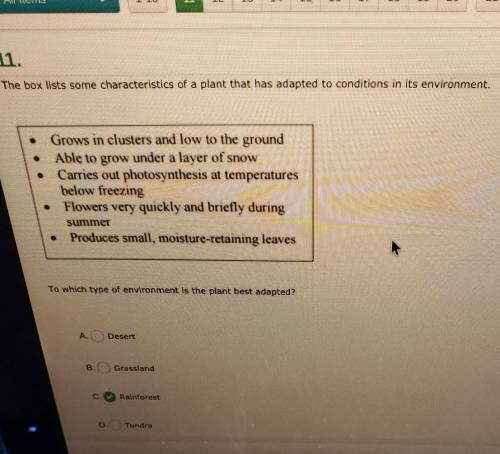
Biology, 07.05.2021 20:50 supasavb99
Pleasee heeelp asap The image is attached
The box lists some characteristics of a plant that has adapted to conditions in Its environment. Grows in clusters and low to the ground Able to grow under a layer of snow Carries out photosynthesis at temperatures below freezing Flowers very quickly and briefly during Summer Produces small, moisture-retaining leaves To which type of environment is the plant best adapted? A. Desert Grassland Rainforest D. (ID Tundra
No links i will report


Answers: 2
Another question on Biology

Biology, 21.06.2019 14:00
Which skill, if it cannot be performed by a 3-year-old child, should alert the nurse that the child may be developmentally delayed?
Answers: 1

Biology, 21.06.2019 20:10
Which process can increase the rate of greenhouse gas emissions into the atmosphere in response to a decrease in albedo
Answers: 1

Biology, 22.06.2019 03:00
Radiometric dating is used to tell the absolute age of materials by studying the decay rate of radioactive isotopes. the decay rates of isotopes are constant and are expressed as .
Answers: 1

Biology, 22.06.2019 04:00
Will mark brainliest i only need the ! 1.use ten beads and a centromere of one color to construct the long chromosome. use ten beads and a centromere of a second color to construct the second chromosome in the long pair. make a drawing of the chromosomes in the space below. 2. for the second pair of chromosomes, use only five beads. 3. now model the replication of the chromosomes. make a drawing of your model in the space below. part b: meiosis i during meiosis i, the cell divides into two diploid daughter cells. 4. pair up the chromosomes to form tetrads. use the longer tetrad to model crossing-over. make a drawing of the tetrads in the space below. 5. line up the tetrads across the center of your “cell.” then model what happens to the chromosomes during anaphase i. 6. divide the cell into two daughter cells. use the space below to make a drawing of the result. part c: meiosis ii during meiosis ii, the daughter cells divide again. 7. line up the chromosomes at the center of the first cell, one above the other. separate the chromatids in each chromosome and move them to opposite sides of the cell. 8. repeat step 7 for the second cell. 9. divide each cell into two daughter cells. use the space below to make a drawing of the four haploid cells
Answers: 1
You know the right answer?
Pleasee heeelp asap The image is attached
The box lists some characteristics of a plant that has a...
Questions



Mathematics, 01.09.2019 22:50

History, 01.09.2019 22:50

Spanish, 01.09.2019 22:50

Mathematics, 01.09.2019 22:50


Social Studies, 01.09.2019 22:50



Social Studies, 01.09.2019 22:50

History, 01.09.2019 22:50


Mathematics, 01.09.2019 22:50


History, 01.09.2019 22:50

History, 01.09.2019 22:50

Chemistry, 01.09.2019 22:50





